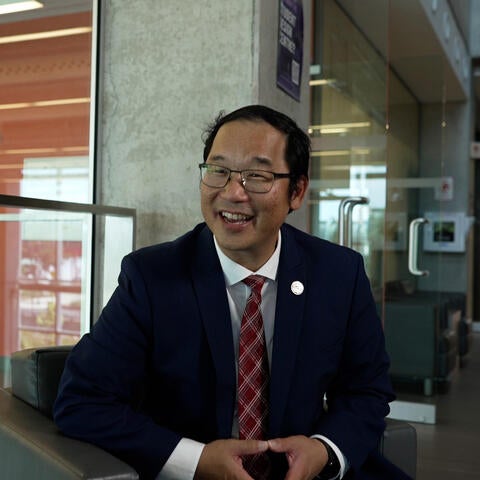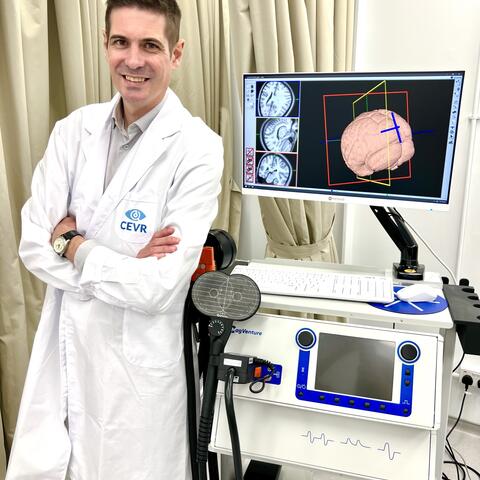
Tackling a global vision crisis
New investments and innovations are creating better access to care

New investments and innovations are creating better access to care
By Claire Francis University Relations
Dr. Stanley Woo
Professor, Faculty of Science
> Director, School of Optometry and Vision Science
The World Health Organization estimates that 2.2 billion people globally have a vision impairment. “These statistics are a call to action. One that my colleagues and I are working to address,” says Dr. Stanley Woo, director of the University of Waterloo’s School of Optometry and Vision Science.
Waterloo has launched one facility in Asia and is in campaign to develop another in Canada to support this mission. The Centre for Eye and Vision Research (CEVR) in Hong Kong has a global reach in partnership with Hong Kong Polytechnic University. The facility is “Waterloo's first footprint into Asia and provides unique opportunities for the University to connect with that region,” says Dr. Ben Thompson, CEO of CEVR.
The Seeing Beyond 2020 campaign will lead to the creation of the Waterloo Eye Institute, a state-of-the-art centre in Waterloo, which will increase access to Optometry’s current delivery of essential care.
These new facilities are an important step to tackling the vision crisis. When combined with cutting-edge technology, they are improving patients’ lives.
Dr. Thompson uses the example of amblyopia, also known as lazy eye, to understand the impact new technology can have on vision care. In this condition, the brain favours processing information from one eye over the other. Normally, children diagnoses with amblyopia are given an eye patch, while adults go untreated. This is because with older patients “there was a view that the adult brain doesn't have enough neuroplasticity to relearn,” says Dr. Thompson. However, with the help of new technologies, this is no longer the case.

Dr. Ben Thompson
Professor, Faculty of Science
> CEO, Centre for Eye and Vision Research
“There are technologies in neurology, like non-invasive brain stimulation, that can be used to alter the way the brain uses information. And we're applying that to vision. It's challenging traditional beliefs in what is possible and disrupting the way that patients may be treated.”
He says that to improve patient outcomes, in addition to adopting a progressive stance, the industry also must evolve and “needs to provide new technologies for people to use”. Today, among innovations being advanced at CEVR is a video game designed specifically so that amblyopia patients can train their eyes to work together.
In Canada, the School of Optemtry is working towards a new tele-optometry centre. “Like mission control for NASA, the idea is that we could have students and faculty participating in the delivery of remote care where access is a challenge,” says Dr. Woo. "The key to success is our partnership with optometrists across the country who already deliver trusted, in-person, comprehensive eye examinations in remote communities. The goal would be for the technology to provide a platform to increase year-round access when geography or seasonal access is a challenge. The technology is evolving rapidly, and we want to help build for the future.”
Optometrists are currently working within remote Indigenous communities in British Columbia to provide care on the ground in these areas. However, due to weather, their access remains seasonal — typically limited to the summer and fall months. Tele-optometry equipment enables optometrists to monitor patients year-round virtually. A tele-optometry centre in Waterloo will help researchers evaluate technology for remote eye care to better understand the patient and provider experience.
Dr. Woo emphasizes the community-based nature of this project. “We're not trying to do everything from Waterloo, Ontario, on our own. It's about creating partnerships with optometrists across the country to provide an evidence-based continuum of comprehensive eye care.”
Both Dr. Thompson and Dr. Woo are optimistic at the progress being made in vision health care and note that Canada has shown valuable leadership in advancing optometry into a new technological era. Facilities such as CEVR and the Waterloo Eye Institute demonstrate the impact technology can have in creating better access to care.
“It's a really exciting time to be an optometrist,” says Dr. Woo. “There is a lot of good that that we can do as a profession.”

Read more
Ribbit’s pilotless planes are set to make the future of air more inclusive and sustainable

Read more
Technology can help solve the challenges of our health-care crisis and transform the future of care

Read more
Working to implement Indigenization on campus
The University of Waterloo acknowledges that much of our work takes place on the traditional territory of the Neutral, Anishinaabeg, and Haudenosaunee peoples. Our main campus is situated on the Haldimand Tract, the land granted to the Six Nations that includes six miles on each side of the Grand River. Our active work toward reconciliation takes place across our campuses through research, learning, teaching, and community building, and is co-ordinated within the Office of Indigenous Relations.